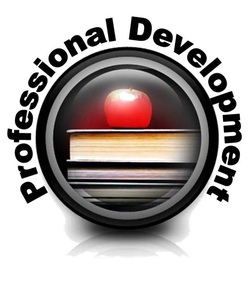Professional Development

(Reference: http://nces.ed.gov/pubs2003/tech_schools/chapter6.asp)
Using technology in the school setting requires training (to develop the knowledge and skills to apply the tools) and professional development (to understand and apply the technology in instruction and school management).
Ideally, technological tools should be a seamless part of the school environment, requiring no more prior learning to apply than, say, electricity. Teachers and students would use technological tools-or not-in learning situations, depending on whether they helped one to learn in that context. If research were required, students would conduct it at the school digital library or at a remote resource as needed. School administrative records and cafeteria food requirements would be updated automatically from entry-screening systems, or perhaps the attendance software on a teacher's personal digital assistant (PDA).
But the technological tools available do not fit together this seamlessly yet, and teachers and staff (and students) need training and professional development in order to make the best use of technology in schools. In fact, providing sufficient development and training to give staff skills and confidence in the use of technology is widely viewed as an ongoing challenge to schools. Calls have repeatedly been made to increase funding for professional development; the recently reauthorized Elementary and Secondary Education Act (ESEA, the "No Child Left Behind Act of 2001," Public Law 107-110) has included in its support for technology the requirement that 25 percent of the funds be devoted to training and professional development.
It is for this reason that assessing the status of training and professional development delivery is important: users of this handbook know that it is critical and that not enough may be reaching the persons who need it. Technology use also has to be taught in the context of educational or management activities, which means that measuring the extent of "pure" technology preparation is very difficult.
In the remainder of this chapter, the term professional development will be used to stand for both training and professional development. Although the handbook authors recognize the differences between these terms, it is awkward to keep referring to both concepts separately when, for purposes of assessment, they are dealt with together.
This guide uses the term professional development to represent learning activities of all kinds for school staff that prepare them to use technology in the school setting. Included under the term are activities such as the following:
Using technology in the school setting requires training (to develop the knowledge and skills to apply the tools) and professional development (to understand and apply the technology in instruction and school management).
Ideally, technological tools should be a seamless part of the school environment, requiring no more prior learning to apply than, say, electricity. Teachers and students would use technological tools-or not-in learning situations, depending on whether they helped one to learn in that context. If research were required, students would conduct it at the school digital library or at a remote resource as needed. School administrative records and cafeteria food requirements would be updated automatically from entry-screening systems, or perhaps the attendance software on a teacher's personal digital assistant (PDA).
But the technological tools available do not fit together this seamlessly yet, and teachers and staff (and students) need training and professional development in order to make the best use of technology in schools. In fact, providing sufficient development and training to give staff skills and confidence in the use of technology is widely viewed as an ongoing challenge to schools. Calls have repeatedly been made to increase funding for professional development; the recently reauthorized Elementary and Secondary Education Act (ESEA, the "No Child Left Behind Act of 2001," Public Law 107-110) has included in its support for technology the requirement that 25 percent of the funds be devoted to training and professional development.
It is for this reason that assessing the status of training and professional development delivery is important: users of this handbook know that it is critical and that not enough may be reaching the persons who need it. Technology use also has to be taught in the context of educational or management activities, which means that measuring the extent of "pure" technology preparation is very difficult.
In the remainder of this chapter, the term professional development will be used to stand for both training and professional development. Although the handbook authors recognize the differences between these terms, it is awkward to keep referring to both concepts separately when, for purposes of assessment, they are dealt with together.
This guide uses the term professional development to represent learning activities of all kinds for school staff that prepare them to use technology in the school setting. Included under the term are activities such as the following:
- familiarization with the operation of equipment and software;
- development of proficiency in the use of the technology "tools" to carry out school tasks;
- the application of software and applications to the management of school activities, whether instructional or administrative; and
- the integration of technology into teaching, learning, and administrative processes.
